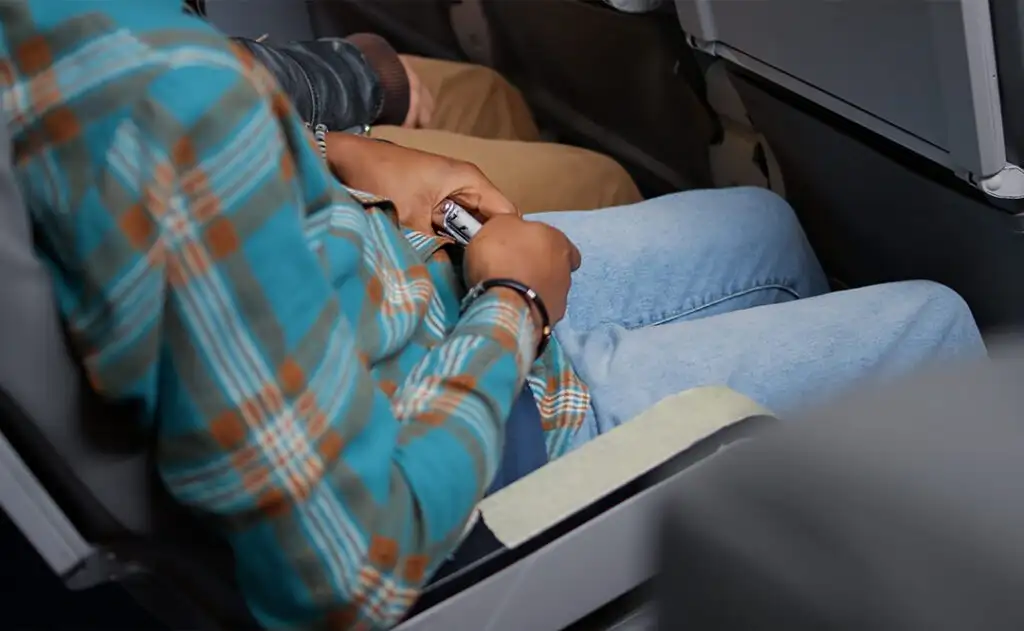Airplanes are by far the safest form of transportation. But as recent incidents (like the Alaska Airlines’ blowout and the Japan Airlines crash) have shown, it’s important to be prepared. Following these tips can increase your chances of survival in an in-flight emergency.
Read this list before your next flight, and remember to put them into practice every time you board a plane.
Keep Your Seatbelt Fastened at All Times

Just because the seatbelt sign is off doesn’t mean your seatbelt should be. Although pilots can often see when turbulence is approaching, “clear air turbulence” can occur unexpectedly, sending passengers flying if they aren’t belted in.
Only unbuckle your seatbelt when you’re getting up to move about the cabin, and only do so when the captain has indicated that it’s safe to do so.
Always Listen to the Pre-Flight Safety Briefing
If you’re a frequent flyer, it’s easy to tune out the pre-flight safety briefing from the flight attendants. However, the safety briefing changes based on the type of plane you’re flying, and it’s important to learn the location of exits and other crucial safety information for every flight.
Likewise, give the safety briefing card in your seatback a quick study, as it will present important safety tips in an easy-to-remember pictorial format. This is especially key if you’re seated in an emergency exit row and could be called upon to open the exit door—you don’t want to waste precious time in an emergency trying to read the directions and figure out how to do it.
Use an Approved Child Seat for Kids
You wouldn’t let your child ride in a car without a seatbelt, so why would you let them fly without one? The Federal Aviation Administration (FAA) recommends buying kids their own seats and utilizing an approved safety device.
The FAA states, “The safest place for your child under the age of two on a U.S. airplane is in approved child restraint system (CRS) or device, not in your lap. Your arms aren’t capable of holding your in-lap child securely, especially during unexpected turbulence, which is the number one cause of pediatric injuries on an airplane.”
The FAA strongly recommends, “Buying a ticket for your child is the only way to guarantee that you will be able to use a CRS. It’s the smart and right thing to do so that everyone in your family arrives safely at your destination.”
To find an FAA-approved CRS device, visit KidsFlySafe.com, which has links to purchase these systems directly.
Count the Rows to the Emergency Exit

Once you’ve taken your seat, take a moment and count the rows to the closest emergency exit, keeping in mind that it might be behind you. In the event of an emergency, the cabin could be dark and filled with smoke, making it hard to see where you can get out.
If you know how many rows stand between you and the exit, you can feel your way out of the plane, even if visibility is nonexistent.
Keep Your Shoes on
If you have to evacuate a plane in an emergency, you may have to run across a hot tarmac that’s littered with sharp objects. Keeping your shoes on during a flight helps you stay prepared in case you have to flee.
When you fly, opt for slip-on or lace-up shoes that will remain securely on your feet if you’re running, and don’t wear high heels—sharp stilettos can puncture the inflatable slides.
You Might Also Like:
• Travel Insurance Coverage: 18 Things Your Policy Won’t Cover• US Government Raises Travel Warning for Two Popular Spring Break Destinations
• TSA to Test Self-Service Screening Lanes
• The 6 Best Places to Travel in January 2024
• Amazon Prime Offers $25 Flights to Students This Holiday Season
We hand-pick everything we recommend and select items through testing and reviews. Some products are sent to us free of charge with no incentive to offer a favorable review. We offer our unbiased opinions and do not accept compensation to review products. All items are in stock and prices are accurate at the time of publication. If you buy something through our links, we may earn a commission.
Related
Top Fares From
Today's Top Travel Deals
Brought to you by ShermansTravel
Italy: 8-Night Rome, Florence & Venice...
Infinity Worldwide Vacations
 vacation
$2335+
vacation
$2335+
Athens to Venice: 9-Night Cruise w/Choice...
Windstar Cruises
 cruise
$3999+
cruise
$3999+
Ohio: Daily Car Rentals from Cincinnati
85OFF.com
 Car Rental
$19+
Car Rental
$19+




